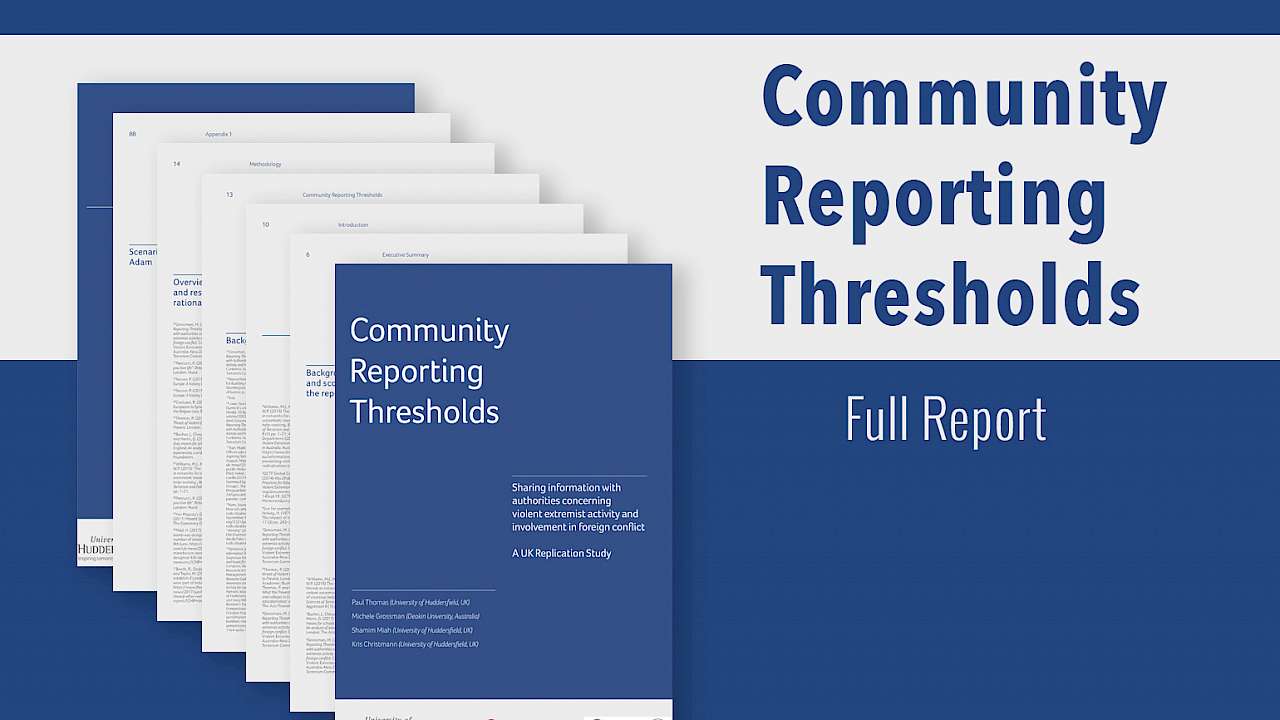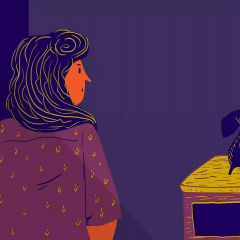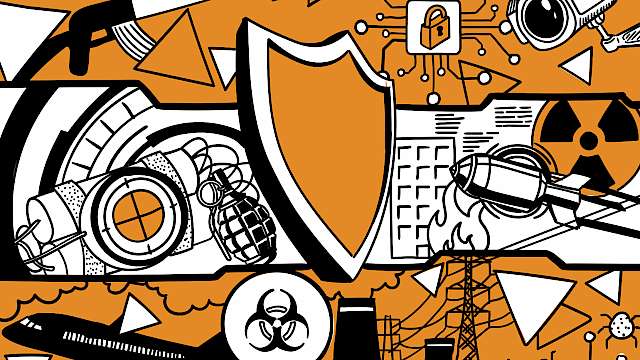Background
The first people to suspect or know about someone becoming involved in planning acts of violent extremism, including planned or actual involvement in overseas conflicts will often be those closest to them: their friends, family and community insiders.
Such individuals are ideally placed to notice any changes or early warning signs that someone is considering violent action to harm others, as well as being able to influence vulnerable younger people away from violent extremist beliefs and settings.
The willingness of those close to potential or suspected violent actors to come forward and share their knowledge and concerns with authorities is thus a critical element in efforts to prevent violent extremist action.
However, while these ‘intimates’ have a vital role to play against potential terrorist threats and offer the first line of defence, very little is known about what reporting of the potential violent extremist involvement of an ‘intimate’ means for community members, particularly their views, experiences and concerns about approaching authorities, especially the police when they have suspicions or knowledge to report.
‘Intimates’ reporting is a critical blind spot in current Countering Violent Extremism (CVE)/Prevent thinking and strategy internationally.
When this research study was conceived, there was no open-source evidence-based research in the UK that investigated the views of either Muslim communities (who are clearly at the forefront of concern for the Prevent Strategy) or of the local government, education and policing professionals at the forefront of Prevent policy implementation on their experiences of and on the processes involved in community reporting on violent extremism concerns in the UK (or indeed, the European Union).
The first study of this kind, conducted with both Muslim communities and government stakeholders, was recently completed in Australia through government-supported academic research partnered by the Australian Federal Police.
Its findings draw on valuable primary data and insights that have contributed to improving current reporting approaches, developed new information and engagement models for use with communities, and provided a substantial number of useable insights and key policy and practice lessons for both communities and for Australian-government policy and personnel, including first responders.
It has formed the basis for a new Australian programme trial on community reporting.
This new UK research project has built on the initial Australian study in order to develop a new, localised and contextually- sensitive understanding of and approaches to community reporting issues in the UK context. The research aims and objectives for this study were as follows:
Identifying triggers, thresholds and barriers for when someone would consider reporting
Understanding more from participants’ perspectives about the experience and process of (considering) reporting on an individual or group who may be involved in, or actively supporting involvement in, overseas conflicts, or violent extremism (including far-right extremism)
Understanding the experiences and perspectives of professional practitioners – both those involved in the police and Prevent and those representing community organisations – around the current reality of community reporting and what approaches could encourage and facilitate greater community sharing of concerns.
Developing from the data usable insights for government and community agencies in future community-focused policies, strategies and campaigns around facilitating and encouraging community reporting related to violent extremism.
The research evidence base
The research aims, objectives and methodology sought to understand and assess through in-depth individual interviews whether community respondents would consider sharing (based on presented scenarios) concerns with authorities about an ‘intimate’ other (a partner, a family member, or a close friend) in relation to their suspected involvement in violent extremist activity at home and/or in planning to travel abroad to take part in violent conflicts.
Experiences and perspectives on community reporting processes and actions were also sought from a range of professional practitioners. This study was designed as a UK replication and development of the earlier Australian project and as such we have drawn heavily on its qualitative design, methods and instruments.
However, the UK study introduces several key refinements to the original Australian research. Firstly, we have significantly expanded the scale of the original study by doubling the number of participants from n=33 to n=66. Secondly, whereas the Australian study only drew on individual respondents self-identifying as ‘Muslim’, we have introduced a new sub-sample of community respondents from marginalised White British majority communities.
This last modification reflects the increasingly varied nature of the extremist threat and the explicitly broad focus of the UK Prevent Strategy on varying forms of extremism.
Thirdly, we have purposively over-sampled young adult community respondents (18–26 year-olds, n=21 or 44%) for a number of reasons.
Young adults have been the core demographic group within domestic terrorist plots in the UK and other Western countries, with the age of those travelling to Syria to join ISIS steadily falling; there has also been important academic evidence that young people may be ‘associate gatekeepers’ in spotting the move of peers towards violent extremism.
48 community respondents and 18 professional practitioners were identified through purposive sampling methods and individually interviewed.
Respondents were primarily drawn from the West Yorkshire and Greater Manchester metropolitan conurbations, with a smaller number from London.
Key findings and conclusions
Community respondents
The overwhelming motivation for reporting by community respondents is care and concern for the ‘intimate’, even if the act damages the relationship/friendship, a key finding very much echoing findings from the earlier Australian study.
Alongside this are strong moral and ethical rationales about a wider social/civic duty to report concerns around such a potentially serious issue. For most respondents, the police are clearly the best-placed people to deal with such situations.
However, given the gravity of reporting someone close to them, virtually all respondents would first go through a staged process of attempting to personally dissuade the intimate and/or drawing on others close to them within their community to intervene before eventually, and often reluctantly, reporting to the police.
Within the staged reporting process, threshold judgments are crucial, with respondents willing to report directly to the police once they judge that the situation has passed beyond a certain point of seriousness and/or tangible evidence. However, such threshold judgments are difficult in the making and often far from clear.
An overwhelming majority of respondents wanted to report to their local police, not counter-terrorism specialists. Alongside this, an overwhelming majority of community respondents also wanted to report to the local police through face-to-face means, so they could judge the reactions of those receiving the report before proceeding further with or hesitating further over their reporting.
The chief reasons for face to face reporting were respondents wanting to assess how seriously their concerns were being taken and actioned, and wanting to have the opportunity for questions about implications (for the reporter, the intimate and others) and what might happen next.
Reflecting this clear and strong preference for face-to-face reporting, telephone modes of reporting, including the national Anti-Terrorism Hotline, were largely seen as unhelpful or inappropriate for something not defined as an emergency, whilst the security and confidentiality of the internet and social media modes were often not trusted or seen as insufficiently interactive.
Much of the public discourse about community reporting focuses on the lack of community reporting of violent extremism involvement and how to encourage greater reporting.
There is much less consideration of what happens for all concerned after a report is made, particularly about an ‘intimate’.
What happens, and what should happen, after reporting is a very significant consideration for most community respondents. Many identified concerns about the negative, collective impacts of reporting, including the different forms of anticipated or experienced backlash against those concerned.
The large majority (although not all) of community respondents want to be kept informed of developments after reporting to the police.
They understand reporting to be a two-way process, with a ‘feedback loop’ that keeps them informed about what happened, the status of the investigation, and what will or might happen next.
Such a feedback loop can have positive impacts on current and future community reporting because it builds trust, accountability and a genuine sense of collective partnerships in countering the harms of violent extremism.
Professional practitioners
For practitioners, the theme of ‘optimising the field’ focuses on the need to build stronger partnerships and a sense of shared responsibilities between communities and the authorities over the threat of violent extremist involvement.
Here, professional practitioners were, by and large, empathetic with and responsive to the complexities and challenges posed by community fears, concerns and conflicts when considering sharing information with authorities about someone close who may be radicalising to violence.
For professional respondents, however, this development can only occur if certain challenges are successfully addressed.
One of the major challenges identified by practitioners is a clear lack of public trust and confidence in various authorities and agencies. This includes the Prevent programme, Channel, and the police as an organisation in some parts of communities.
Practitioner respondents recognise and often sympathise with the very real community fears of reporting consequences, including the potential for overreaction by authorities to tentative expressions of concern that are the domain of ‘Prevent’, not ‘Pursue’.
However, practitioners believed there is insufficient recognition of and engagement with the role of communities in safeguarding contexts and they thought this directly feeds into a lack of broad community awareness about reporting processes, modes, channels and outcomes.
Specific challenges around increasing community reporting identified by professional practitioners included maintaining the protection of those who report from both community- and media-led forms of social harm, including isolation, ostracism and backlash.
The potential for community reporting systems and cultures that work for all parties is hampered, in the view of professional practitioners, by uneven training and awareness by frontline public sector personnel with a Prevent Duty in relation to what should and shouldn’t be reported onward.
Additionally, respondents recognised the ineffectiveness and inappropriateness of the national Anti- Terrorism Hotline for reports at the early stages of concern about an intimate, as well as the remote, intimidating nature of the Hotline.
Professional practitioner respondents also identified significant opportunities to encourage community reporting. These broadly focus on the opportunity to build stronger and deeper relationships with key community leaders and organisations to enhance partnerships in preventing violent extremism, including those that may fall outside the current, formal Prevent framework.
Within this, practitioners felt there could be more explicit and committed policy support for the strengthening of community brokerage models to enhance reporting channels using trusted local intermediaries.
Alongside this could come the fostering of more opportunities and mechanisms for open dialogue and partnerships on the risks and mitigation strategies for violent extremism.
For this to be meaningful there is a pressing need to develop formal support mechanisms for those who report, and identifying early what individuals’ support needs may be when they first come forward.
Common ground: shared community and practitioner perspectives
The project findings make clear that both community respondents and professional practitioners already have a number of shared understandings around existing reporting processes and dynamics, as well as challenges and improvements that can be made to enhance better reporting outcomes.
Both groups have acknowledged the significant emotional and social challenges involved in sharing concerns about loved ones and other ‘intimates’ with authorities, and have suggested ways to ensure that trust, confidentiality and minimisation of harmful social impacts associated with community reporting can be pursued.
Both groups have also emphasised the value of strengthening genuine community partnerships so that those who come forward feel they are doing so with the recognition, validation and support that is a key ingredient of willingness to share difficult information about others who are close and cared for.
There is a shared understanding that, motivated as it is by care and concern, the more personalised and localised the reporting process is, the stronger it will likely be, and both community and professional respondents expressed reservations about more remote and impersonal methods of bringing forward concerns during the early stages for someone who may potentially be radicalising to violence.
However, community respondents were more interested in face to face reporting to local police, as well as other community figures and intermediaries, than professional practitioners believed to be the case.
There are clear implications here for rethinking the structures and mechanisms that are put into place in local areas that can facilitate face to face sharing of concerns.
Professional practitioners were also less aware than community respondents of the importance of post-reporting support and information, and more focused on the dilemmas around post-report information sharing in terms of potentially compromising confidentiality and the legal or investigative integrity of their work.
These common understandings and points of divergence both point towards ways in which the future landscape of community reporting can be further developed and refined, and below we detail some key considerations and potential strategic directions for policy and practice based on the project’s findings.
Future considerations for policy and practice
Strategic direction 1: Consider rethinking the tone, content, and targeting of social messaging initiatives around community reporting
Counter-terrorism/ Prevent policy and practice can benefit from shifting toward greater recognition that the primary drivers for those considering reporting concerns about an ‘intimate’ will be care and concern for their welfare and the prevention of further harms to both the intimate and others in the wider community and society.
Therefore, public messaging and policy practice that emphasises ‘safeguarding’ and ‘health promotion' messaging in tone and content, rather than a focus on criminality and threat, is likely to be more effective in encouraging community reporting concerning intimates who may be radicalising to violence.
Strategic direction 2: Sharing concerns with authorities is a staged process
Preventing violent extremism policy and practice would benefit from applying in greater depth the understanding that a staged process of sharing concerns will be very common for community members, with advice, guidance and support first sought within family and friendship networks and within the local community before reporting to the police occurs.
Some individuals will only go beyond this to contact the police with reluctance and with support from others. Community intermediaries and conduits thus play an absolutely vital role in the ‘supply chain’ of reporting processes and pathways.
Strategic direction 3: Localise and personalise the reporting process
A large majority of community respondents expressed a strong preference to report concerns to local police staff and other community sites through face-to-face interaction.
This means foregrounding in policy and practice the role of mainstream neighbourhood policing teams in such community partnership work, as well as dialogue with and training for mainstream front-line policing personnel to ensure that they are ready and feel equipped to positively engage with reports of concerns when they present.
Strategic direction 4: Develop support mechanisms for reporters
Community respondents have very significant worries and concerns about what happens to the ‘intimate’, to themselves, to their family, and to the wider community after they take the grave decision to report someone close to them.
They want support and guidance, protection, and to be kept informed as far as possible about what is and will be happening through a ‘feedback loop’ that acknowledges them as partners in keeping people and communities safe.
Strategic direction 5: Clarify reporting mechanisms
There is confusion and uncertainty for many community respondents, and for some professional practitioners, around how reporting processes actually work and what choices people may have in coming forward.
Strong consideration can be given to developing both an information protocol around reporting processes for communities, and to standardising the information management of reports to enable effective and efficient cross-sharing of information and also follow-up with those who come forward.
Copyright Information
As part of CREST’s commitment to open access research, this text is available under a Creative Commons BY-NC-SA 4.0 licence. Please refer to our Copyright page for full details.






